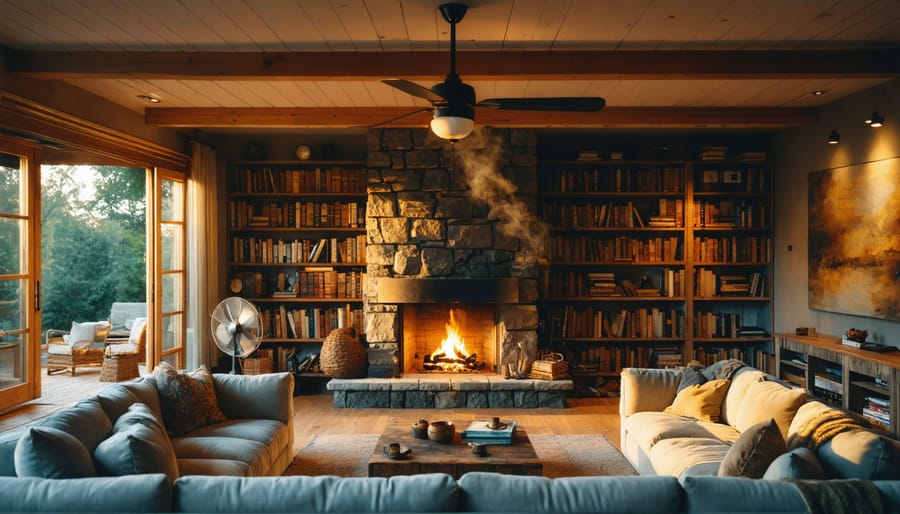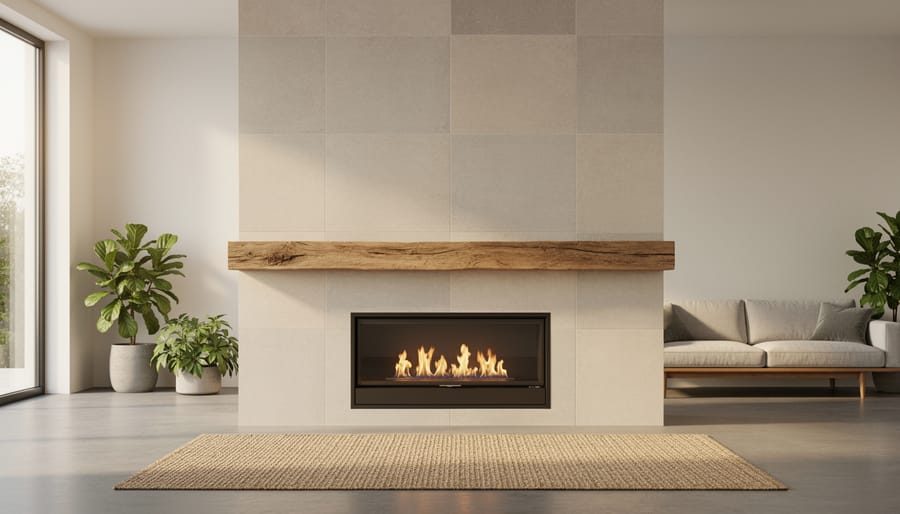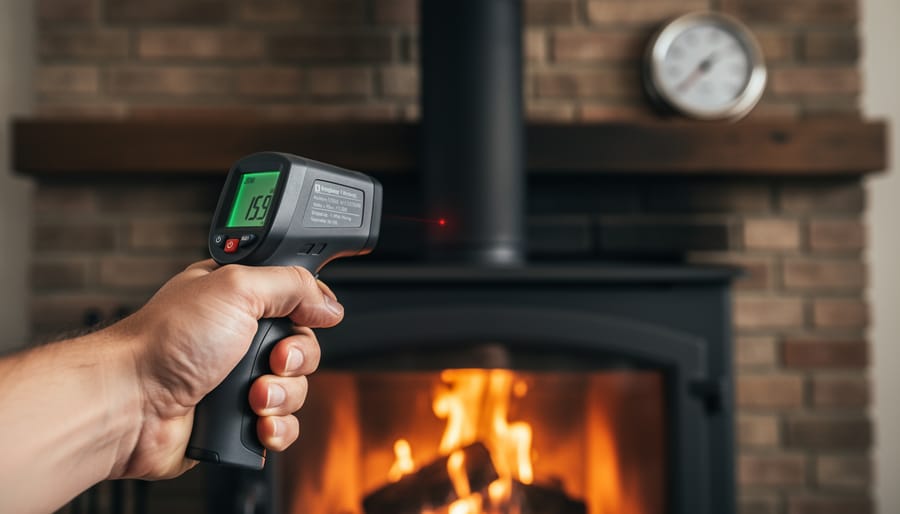Understanding how warm air moves through your space transforms a struggling fireplace into an efficient heating powerhouse. Air circulation diagrams reveal the invisible patterns that determine whether heat stays trapped near your ceiling or flows throughout your entire room, making the difference between shivering in corners and enjoying cozy comfort everywhere.
These visual guides show exactly where hot air rises, how cold air descends, and where circulation bottlenecks rob your home of warmth. When you know how to read these diagrams, you’ll spot why your fireplace heats the mantel beautifully but leaves your reading chair frigid—and more importantly, you’ll discover precisely where to position fans, adjust vents, or modify your room layout for optimal heat distribution.
Most homeowners waste energy fighting against natural airflow instead of working with it. A properly interpreted circulation diagram acts as your heating blueprint, showing you the pressure zones, thermal layers, and air currents already present in your room. This knowledge empowers you to make strategic improvements—like positioning a ceiling fan to push warm air downward or opening doorways to create beneficial cross-circulation—that multiply your fireplace’s effectiveness without increasing fuel consumption.
Whether you’re troubleshooting cold spots, planning a new fireplace installation, or simply wanting to maximize the warmth from every log you burn, mastering air circulation diagrams gives you the insights professional HVAC specialists use to optimize heating systems. The principles are straightforward, the improvements immediate, and the comfort level transformative.
Understanding How Air Moves Around Your Fireplace
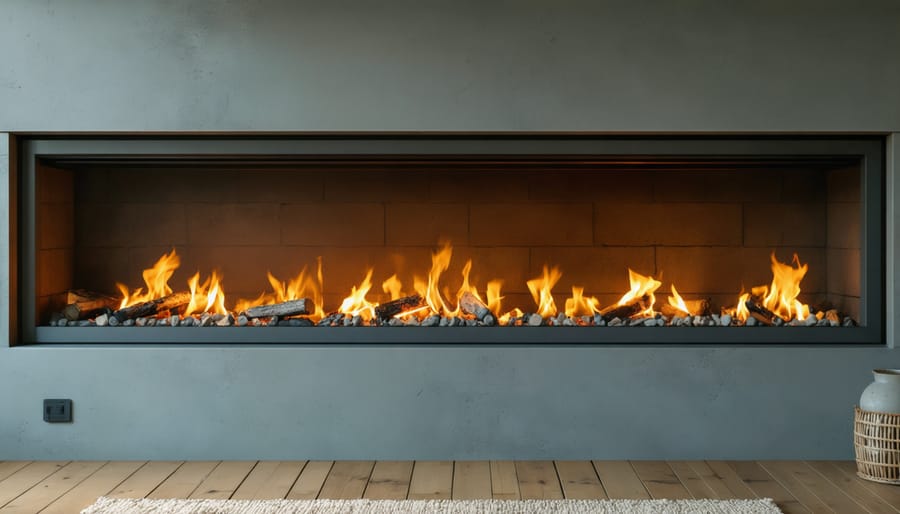
The Natural Air Circulation Pattern
When you light a fire in your fireplace, you’re actually setting in motion a beautiful, natural dance of air movement throughout your home. Understanding this pattern is the first step toward making your fireplace work more efficiently for you.
At the heart of this process is the **chimney draft effect**. As flames heat the air directly above them, that warmed air becomes lighter and more buoyant than the cooler air surrounding it. This heated air naturally rises up through the chimney, creating what we call “draft.” Think of it like opening a window at the top of your room—the warm air wants to escape upward, and cooler air rushes in to take its place.
This creates a circulation loop in your room. The warm air rises from the fireplace toward your ceiling, spreads across the top of the room, and gradually cools as it moves away from the heat source. As it cools, it becomes denser and begins to sink along the walls farthest from your fireplace. This cooler air then travels along the floor back toward the fireplace, where it gets warmed again, and the cycle continues.
While this natural circulation is happening, your fireplace is also drawing in air from the room to feed the flames—this is called combustion air. Without adequate air supply, your fire won’t burn efficiently, which is why understanding and sometimes enhancing this natural pattern becomes essential for creating that cozy, warm atmosphere you’re after.
Why Poor Circulation Wastes Heat and Money
Without proper air circulation, your beautiful fireplace might be working overtime while your feet stay frustratingly cold. Here’s what’s happening: warm air naturally rises, creating a thick layer of toasty heat that gets trapped uselessly against your ceiling. Meanwhile, the cold air settles near your floors, creating an uncomfortable temperature gap that can exceed 15-20 degrees between head and toe level.
This stratification problem doesn’t just affect comfort—it hits your wallet hard. When warm air accumulates overhead, your thermostat reads the room as colder than it actually is at ceiling height, triggering your heating system to work harder. You’re essentially heating the upper portions of your room twice while the living space where your family actually spends time remains chilly.
Different rooms can develop their own microclimates too. The room with your fireplace becomes sweltering while adjacent spaces stay frigid, forcing you to either waste heat by opening windows or run additional heating sources. This inefficiency can increase your heating costs by 25-40% compared to a home with balanced air movement.
The environmental impact matters too. When you’re burning more fuel—whether wood, gas, or electricity—to compensate for poor circulation, you’re unnecessarily increasing your carbon footprint. Understanding how air moves through your space is the first step toward creating an eco-friendly, comfortable, and cost-effective heating solution that works with your fireplace’s natural warmth rather than against it.
Reading Your Room’s Air Circulation Diagram
Key Elements in Air Flow Diagrams
Understanding air circulation diagrams is easier than you might think – these visual guides use simple symbols to show how warmth moves throughout your space. Once you grasp the basics, you’ll be able to diagnose why your fireplace might not be heating your room effectively and identify solutions.
**Hot Air Streams** are typically shown with red or orange arrows pointing upward. Since heated air naturally rises, you’ll see these flowing from your fireplace toward the ceiling. This rising warmth is wonderful for ambiance, but it’s also why your toes might feel cold while your ceiling fan collects all the heat!
**Cold Air Return** appears as blue arrows flowing downward or along the floor. Cool air is denser and sinks, creating a continuous loop as it gets drawn back toward your fireplace to be reheated. This natural circulation pattern is key to understanding how to optimize your heating system.
**Stagnant Zones** are often marked with gray shading or dotted circles. These are problem areas where air barely moves – think corners, spaces behind furniture, or rooms separated by doorways. Identifying these zones helps you target where to place fans or adjust your room layout.
**Arrow Thickness** matters too. Thicker arrows indicate stronger air movement, while thin arrows show weaker flow. This helps you visualize where circulation bottlenecks occur and where adding a simple ceiling fan or opening a doorway could make a significant difference in distributing that cozy fireplace warmth throughout your home.
Identifying Problem Areas in Your Space
Understanding where air circulation falls short in your space is the first step toward creating a more comfortable, efficiently heated home. Start by doing a simple walkthrough of your room when your fireplace is running. Notice how the temperature feels as you move from one area to another—dramatic differences between spots near your fireplace and distant corners signal poor circulation.
Here’s a practical test: light an unscented incense stick or observe smoke from a candle (safely, of course) in various locations around your room. Watch how the smoke moves. Does it drift sluggishly? Does it seem trapped in certain areas? Healthy air circulation creates gentle, consistent movement throughout the space. Stagnant smoke indicates dead zones where warm air isn’t reaching.
Pay attention to comfort levels too. If you’re constantly adjusting your thermostat or layering blankets in one part of the room while feeling overheated near the fireplace, that’s your home telling you something needs attention. Cold spots near windows, stuffy areas near the ceiling, or drafts along the floor all point to circulation challenges that, once identified, can be addressed with strategic solutions to maximize your fireplace’s warming potential while keeping your home eco-friendly and energy-efficient.
Strategic Room Layouts That Maximize Heat Distribution

Furniture Placement for Better Air Flow
Strategic furniture placement is one of the most overlooked aspects of maintaining excellent air flow around your fireplace. Think of your room as a highway system—furniture pieces are like buildings that can either guide traffic smoothly or create frustrating bottlenecks.
Start by positioning your sofa at least 18-24 inches away from walls and your fireplace. This gap creates essential pathways for warm air to circulate behind and around seating areas, preventing heat from getting trapped. Angle your furniture slightly rather than pushing everything against walls—this naturally encourages air movement throughout the space while creating a more intimate, conversational seating arrangement.
Bookshelves and tall storage units deserve special attention. Place them perpendicular to your fireplace rather than directly beside it, as this prevents them from acting as barriers that block heat distribution. If you must position a bookshelf near your fireplace, leave at least 12 inches of clearance on both sides to maintain proper air circulation techniques.
Avoid creating “furniture walls” that divide your room into separate zones. Coffee tables and ottomans work beautifully because they’re low-profile pieces that don’t impede air flow at higher levels where warm air naturally rises. Similarly, choose furniture with exposed legs rather than solid bases—this allows air to pass underneath, creating additional circulation pathways.
Consider seasonal adjustments too. During peak heating months, you might move a reading chair slightly farther from the fireplace to improve overall room circulation, embracing both comfort and energy efficiency in your cozy living space.
Creating Circulation Pathways Between Rooms
Your fireplace can become a whole-home heating solution when you thoughtfully design circulation pathways between rooms. Think of your home’s layout as a network of channels that either trap or distribute that wonderful warmth.
Start by examining doorway positioning. Wide, centrally-located openings act as natural heat highways, allowing warm air to flow freely from your fireplace room into adjacent spaces. If you’re renovating or building, consider archways instead of standard doors—they create unobstructed pathways that maximize heat distribution while maintaining an open, welcoming atmosphere.
Open floor plans are champions of heat circulation, removing barriers that block warm air movement. Even partial openings between spaces—like a pass-through or half-wall—can dramatically improve heat flow while preserving some room definition. This approach aligns beautifully with eco-friendly heating goals, helping you reduce reliance on supplemental heating systems.
Strategic connecting spaces like hallways serve as circulation arteries when properly utilized. Place a small fan in these transitional areas to gently guide warmth throughout your home. Remember, you’re not just moving air—you’re creating a cozy, efficient living environment that honors both comfort and sustainability. The key is working with your home’s natural layout while identifying opportunities to enhance flow without major structural changes.
Using Fans and Vents to Enhance Fireplace Circulation
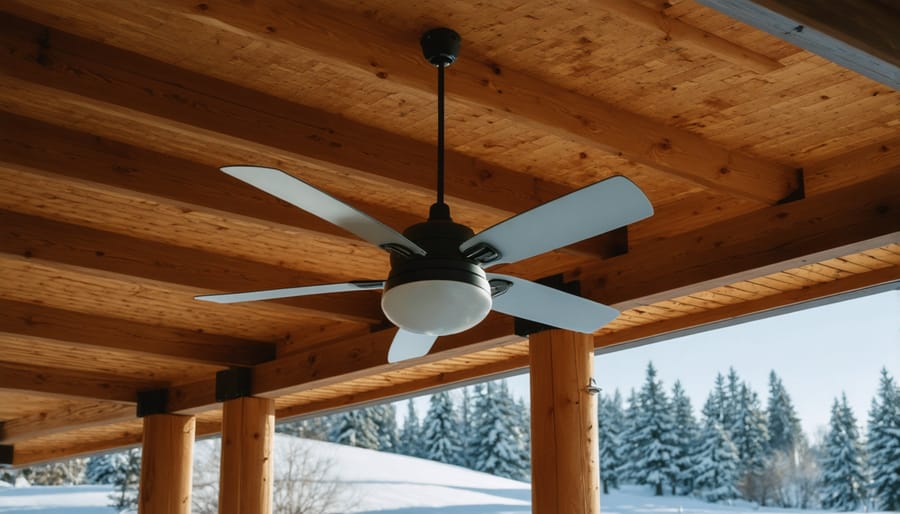
Ceiling Fan Direction and Speed Settings
Your ceiling fan can be a game-changer for fireplace efficiency when you understand how to use it properly. The secret lies in knowing which direction to run it and at what speed.
During winter months when your fireplace is the star of the show, set your ceiling fan to rotate clockwise at a low speed. This reverse direction gently pushes warm air that’s accumulated near the ceiling back down into your living space without creating an uncomfortable draft. Think of it as quietly redistributing that precious heat your fireplace is working so hard to produce.
In summer, reverse this to counterclockwise rotation to create a cooling downdraft—but that’s a topic for warmer days when your fireplace is taking a well-deserved rest.
The speed setting matters tremendously. When your fireplace is burning, keep your fan on its lowest setting. High speeds create too much turbulence and can actually pull warm air away from where you’re sitting, making the room feel drafty despite the roaring fire. Low and slow wins this race, allowing air circulator fans to work harmoniously with your ceiling fan for optimal distribution.
Position matters too. If possible, ensure your ceiling fan sits at least eight feet from the floor and centered in the room for balanced air movement. This height allows warm air to circulate effectively without interfering with your fireplace’s natural convection pattern.
Regular maintenance keeps everything running smoothly—dusty blades work harder and less efficiently. Take time to maintain your fans seasonally for peak performance and energy savings that complement your eco-friendly heating goals.
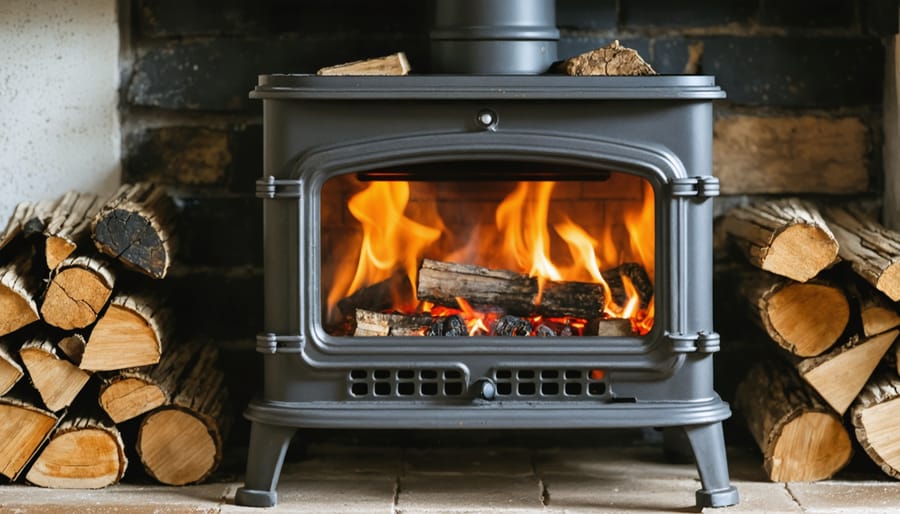
Fireplace Blowers and Heat-Powered Stove Fans
When it comes to maximizing the warmth from your fireplace, specialized blowers and heat-powered fans can be absolute game-changers. These clever devices work alongside traditional methods like using air circulators to distribute heat more evenly throughout your space.
Fireplace blowers, also called fireplace inserts or forced-air systems, use electricity to pull warm air from around the firebox and push it into your room through vents. They’re particularly effective with zero-clearance and insert fireplaces, where they can increase heat output by up to 50%. Installation typically requires professional help for built-in units, though some retrofit kits are DIY-friendly for handy homeowners.
Heat-powered stove fans offer an eco-friendly alternative that needs no electricity at all. These ingenious devices sit atop your wood stove or fireplace and use the Seebeck effect—converting heat differential into mechanical energy—to spin their blades automatically. As your fire burns, the fan spins faster, gently circulating warm air throughout the room. They’re perfect for off-grid living or reducing your carbon footprint.
For masonry fireplaces, tube-style blower systems work best, tucking neatly into the firebox opening. Gas fireplaces often come with built-in blowers, but aftermarket options can boost performance. Wood stoves pair beautifully with heat-powered fans positioned on the stovetop.
Consider noise levels, ease of cleaning, and compatibility with your specific fireplace type when choosing your circulation solution. These specialized fans transform your fireplace from a beautiful focal point into an efficient, whole-room heating source.
Balancing Fresh Air Intake With Heat Retention
Managing Outside Air Vents and Combustion Air
Proper combustion air management is essential for your fireplace to burn efficiently while keeping your home comfortable. Traditional fireplaces pull air from inside your room for combustion, which means they’re literally burning the warm air you’ve already heated – not exactly eco-friendly or economical!
Modern direct-vent systems offer an elegant solution to this challenge. These innovative designs draw combustion air directly from outside through a sealed pipe system, eliminating the competition between your fireplace and your living space. Think of it as giving your fireplace its own dedicated air supply, so it doesn’t steal from your cozy environment.
If you have a traditional fireplace, installing an outside air kit can dramatically improve performance. These kits create a dedicated pathway for combustion air, reducing drafts and preventing your heating system from working overtime to replace lost air. Position outside air vents carefully – you want them close to the firebox but away from high-traffic areas where cold drafts might create discomfort.
For wood-burning enthusiasts, ensuring adequate combustion air isn’t just about comfort; it’s about achieving a cleaner, more complete burn. Better airflow means less smoke, fewer emissions, and more heat – a true win-win for both your home and the environment. Always consult a certified professional when adding ventilation to ensure proper sizing and placement.
Preventing Drafts While Maintaining Safety
While maximizing heat circulation is important, creating an airtight home can actually work against your fireplace’s performance and your family’s safety. The key is finding that sweet spot where you’re reducing wasteful drafts without starving your fireplace of the oxygen it needs to burn efficiently.
Start by identifying the real culprits—those sneaky air leaks around window frames, door jambs, electrical outlets, and baseboards that let cold air seep in while your fireplace is working overtime. Weatherstripping and caulking these problem areas can dramatically improve your home’s heat retention without affecting the intentional airflow your fireplace requires.
Here’s what many homeowners don’t realize: your fireplace needs a steady supply of fresh air to operate safely and efficiently. If your home is too tightly sealed, the fireplace will pull air from wherever it can find it—sometimes creating backdrafts or inadequate combustion that leads to dangerous carbon monoxide buildup. This is especially true for traditional wood-burning fireplaces and older gas models.
Consider installing a carbon monoxide detector near your fireplace as your first line of defense. It’s a small investment that provides invaluable peace of mind while you optimize your heating setup.
When managing doors and windows during fireplace use, crack open a window in the same room—just slightly—to provide makeup air. This ensures proper combustion while maintaining the warm, cozy atmosphere you’re creating. Think of it as giving your fireplace room to breathe, much like you would when tending to any living flame.
For a truly eco-friendly solution, modern direct-vent fireplaces draw combustion air from outside through a dedicated pipe, eliminating the draft dilemma entirely while maximizing efficiency.
Seasonal Adjustments for Year-Round Efficiency
Cold Weather Circulation Strategies
Winter presents unique challenges for maintaining comfortable, efficient air circulation in your home. When your fireplace is working hard to combat frigid outdoor temperatures, understanding how to optimize air flow becomes crucial for both comfort and energy efficiency.
During cold weather, warm air from your fireplace naturally rises and can become trapped near the ceiling, leaving floor-level spaces chilly. Combat this by running ceiling fans on low speed in reverse (clockwise) to gently push warm air downward without creating uncomfortable drafts. This simple strategy can reduce the temperature difference between ceiling and floor by up to 10 degrees.
Managing humidity is equally important during heating season. Dry winter air combined with fireplace operation can create uncomfortable conditions and even affect your home’s structure. Consider placing a humidifier near your fireplace area, but not too close to heat sources. Proper moisture levels (30-50%) help air feel warmer at lower temperatures, allowing you to reduce heating intensity.
For extreme temperature differences, weatherstrip doors and windows to prevent cold air infiltration that disrupts your carefully established circulation patterns. Focus your fireplace operation during peak evening hours when temperature differentials are greatest, and always ensure fresh air intake is adequate for safe, eco-friendly combustion while maintaining comfortable indoor air quality.
Understanding how air moves through your space is truly empowering—and now you have the knowledge to make meaningful changes that enhance both comfort and efficiency. The beauty of optimizing air circulation is that you don’t need to tackle everything at once. Start by simply observing how air flows around your fireplace during your next fire. Notice the warm spots, the cold corners, and where drafts seem to originate.
Begin with one or two simple improvements: perhaps repositioning a piece of furniture that’s blocking heat flow, or adding a ceiling fan to redirect warm air downward. These small adjustments can deliver surprisingly significant results in how evenly your room heats and how much you rely on supplemental heating sources. Many homeowners discover they can reduce their thermostat settings by several degrees once air circulation is optimized, translating to noticeable savings on energy bills.
Remember that effective air circulation isn’t just about comfort—it’s an eco-friendly approach to heating that maximizes the natural warmth your fireplace provides while minimizing waste. By working with your home’s natural airflow patterns rather than against them, you’re creating a more sustainable heating solution that benefits both your wallet and the environment.
As you implement these techniques, always prioritize safety. Keep combustible materials away from heat sources, maintain proper clearances, and ensure your fireplace and chimney are regularly inspected. With thoughtful observation and gradual improvements, you’ll create a warmer, more inviting space that truly embraces the fireplace lifestyle.

